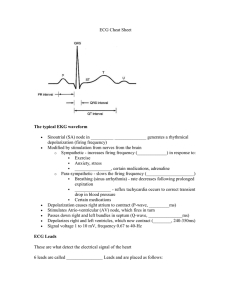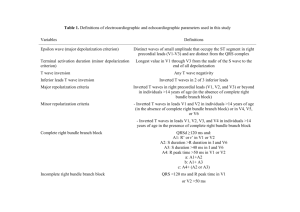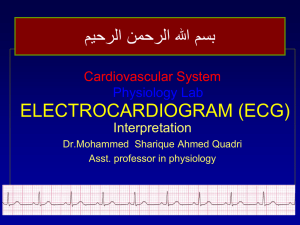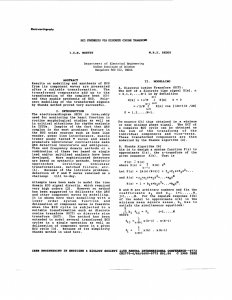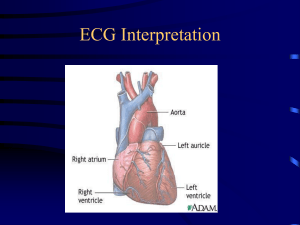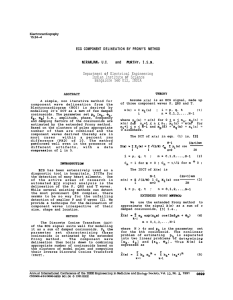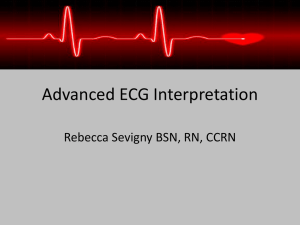secondary ST-T abnormalities in V 1
advertisement
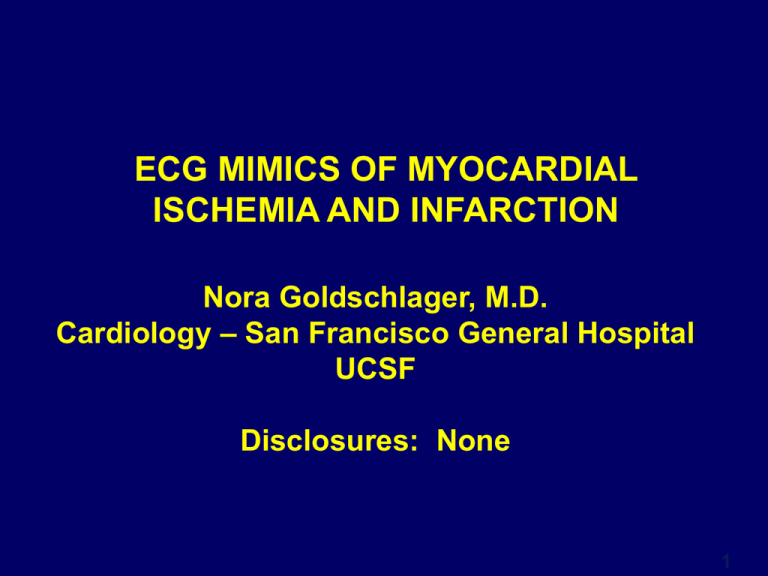
ECG MIMICS OF MYOCARDIAL ISCHEMIA AND INFARCTION Nora Goldschlager, M.D. Cardiology – San Francisco General Hospital UCSF Disclosures: None 1 PITFALLS IN THE ACCURACY OF THE ECG DIAGNOSIS OF ACUTE MI • Nonspecific ST/T wave abnormalities • Age of Q-waves (may not be known) • Paced ventricular rhythm • Left bundle branch block • Right bundle branch block: secondary ST-T abnormalities in V1-3 can mimic anterior wall MI; tall R waves in V1-2 can mimic posterior wall MI • Nonspecific intraventricular conduction delay with repolarization abnormalities 2 DIAGNOSIS OF ACUTE MI IN LBBB • 1 mm ST segment change in same direction as terminal QRS • More than 5 mm ST elevation in direction opposite to QRS • Sgarbossa criteria (NEJM 1996;334:481) - ST-elevation > 1 mm in lead with concordant QRS complex - ST-depression > 1 mm in leads V1, V2 or V3 - ST-elevation > 5 mm in lead with discordant QRS complex 5 points 3 points 2 points 3 4 Same patient, baseline ECG obtained 6 months earlier 5 6 PITFALLS IN THE ECG DIAGNOSIS OF ACUTE MI: MI MIMICS - 1 • Early repolarization • Electrolyte disorders Hyperkalemia Hypokalemia • Inflammatory conditions Pericarditis (PR depression, scooped ST segments, J point elevation) Myocarditis • Conduction system disorders Fascicle blocks Anterior qV2-3, 1, aVL Poor R progression Posterior q II, III, aVF 7 PITFALLS IN THE ECG DIAGNOSIS OF ACUTE MI: MI MIMICS - 2 • • • Accessory pathways: - ventricular pre-excitation Cardiac conditions LVH, RVH HCM Arrhythmias Wide QRS tachycardias Ectopic atrial tachycardias with prominent Ta waves Paced ventricular rhythm with inapparent pacing artifacts Junctional or ventricular tachycardias with retrograde conduction Atrial flutter with flutter waves pseudo ST or Brugada pattern 8 PITFALLS IN THE ECG DIAGNOSIS OF ACUTE MI: MI MIMICS - 3 • Other Osborne waves Pneumothorax with mediastinal shift Double standardization 9 EARLY REPOLARIZATION • • • • • • • Prevalence about 1% Male prevalence (87% in men, 33% in women) Age less than 50 (OR 3.3) High prevalence in black and Asian races High prevalence in athletes Benign clinical course Exercise and hyperventilation normalize the pattern 10 EARLY REPOLARIZATION: ECG FEATURES • • • • • • • J point elevation Terminal R wave notch Upwardly concave ST segments PR segment depression often seen PR interval often short Bradycardia common Best seen in precordial leads (usually V2-4); unusual in limb leads • Early transition common • T waves tall and asymmetric • U waves often present (may be negative) 11 HYPERKALEMIA vs ANTERIOR OR INFEROPOSTERIOR WALL MI vs BRUGADA PATTERN 12 13 14 15 16 17 18 19 20 21 Isoelectric mimicking pauses 22 23 PR ST scoop 24 25 26 27 RETROGRADE P WAVES – PSEUDO ST DEPRESSION 28 Flutter - Pseudo ST elevation 29 30 31 32 33 34 37 y.o. O “found down” 35 6 hrs. later: T° 25° 30° C 36 J (OSBORNE) WAVE Results from electrical heterogeneity between ventricular endo- and epicardium during repolarization Seen in: • • • • • • • Hypothermia Hypercalcemia Intracranial (subarachnoid) bleed Brugada syndrome Coronary vasospasm Idiopathic VF ? ischemia 37 38
